Brief Summary
Multiplying fractions is relatively straightforward. These are the steps:
- multiply the numerators
- multiply the denominators
- reduce the fraction to its simplest form
These three steps are illustrated below:
Have a look at the fraction worksheet generator. It provides limitless multiplying fraction questions including with whole numbers and with mixed numbers.
Introduction
We know that a fraction is a number that is in the form of $\frac{p}{q}$ where q ≠ 0. While we need to take out the LCM when we need to add or subtract two fractions, the multiplication of fractions is completely different. Here we don’t need to check the denominators of the fractions and find out the LCM so as to make them equal. Instead, in the multiplication of fractions, we treat both numerators and denominators separately. In order to multiply two fractions, we can simply multiply the respective numerators and the denominators with each so as to get our answer. But, for larger numbers and numbers with common factors, this might not be the only step involved. So, how do we multiply two fractions? There is one general method of multiplication of fractions. But before understanding the method of multiplication, it is important to understand how to reduce a fraction in its lowest form or standard form.
Reducing a Fraction to its Simplest Form
As the name suggests, a fraction is said to be in the simplest form if the numerator ad denominator has no common factor other than 1 or we say that these are co-primes.
Let us understand this by an example:
Suppose we have a fraction $\frac{24}{56}$ and we want to reduce it to its lowest form.
First of all, we will write the factors of both the numerator and the denominator. We have
The factors of 24 are 1, 2, 3, 4, 6, 8, 12 and 24
The factors of 56 are 1, 2, 4, 7, 8, 14, 28 and 56
From above we can see that the Highest Common Factor (HCF) of 24 and 56 is 8. Therefore we will divide both the numerator and the denominator by 8 to make the numbers a pair of co-primes.
We will get
$\frac{24\div 8}{56\div 8}=\frac{3}{7}$
The fraction $\frac{24}{56}$ has now been reduced to $\frac{3}{7}$. 3 and 7 are prime numbers and do not have any common factors between them. Hence we can say that the simplest form of the fraction $\frac{24}{56}$ is $\frac{3}{7}$.
We do not need to reduce a fraction to its simplest every time. There may be instances where the numerator and the denominator of a fraction are already in a form such that they do not have any factors in common, though they might not be prime numbers. For example, the numbers 8 and 81 both are not prime numbers, yet they do “not have any factor in common. Therefore, we put them in a fraction, say $\frac{8}{21}$, they are already in the lowest form. Let us consider another example.
Suppose we have a fraction $\frac{15}{34}$ and we want to reduce it to its lowest form.
First of all, we will write the factors of both the numerator and the denominator. We have
The factors of 15 are 1, 3, 5 and 15
The factors of 34 are 1, 2, 17 and 34
We can see that 15 and 34 have no common factor between them other than 1. Hence the said fraction is said to be in its simplest form.
Now, let us understand what are the general steps for the multiplication of fractions.
General Steps Involved in multiplying two or more Fractions
The following steps are involved in multiplying two or more fractions:
- First, we need to multiply all the numerators.
- Next, we need to multiply all the denominators
- Lastly, we need to simplify the fraction, if required
Therefore, we can say that
Product of fractions = $\frac{Product\,of\,the\,Numerators}{Product\,of\,the\,denominators}$
Let us now apply these steps in different conditions.
Multiplication of a Fraction by a Whole Number
What will we get when we multiply 4 by $\frac{1}{5}$?
Remember that every whole number can be written in the form of a fraction where it has 1 as the denominator. Therefore,
We can write 4 as $\frac{4}{1}$.
Now we have two fractions, $\frac{4}{1}$ and $\frac{1}{5}$.
Performing the steps we have learnt in the above section, we have:
$\frac{4}{1}\times \frac{1}{5}=\frac{4\times 1}{1\times 5}=\frac{4}{5}$
In general,
Fraction x Whole Number = $\frac{Numerator\,of\,the\,Fraction\,\times \,Whole\,Number}{Denominator\,of\,the\,Fraction}$
Let us understand this by another example.
Alice wants to buy 12 bananas. The shopkeeper tells us that one banana costs £$\frac{1}{5}$. How much is she required to pay the shopkeeper?
Solution
We have been given that Alice has 12 bananas.
The cost of 1 banana is £$\frac{1}{5}$.
Hence,
The cost of 12 bananas will be £$\frac{1}{5}\times 12$
This is an example of a whole number multiplied by a fraction.
So, we have
Fraction x Whole Number = $\frac{Numerator\,of\,the\,Fraction\,\times \,Whole\,Number}{Denominator\,of\,the\,Fraction}$
Therefore,
£$\frac{1}{5}\times 12$ = £$\frac{1\times 12}{5}$= £$\frac{12}{5}=$
Hence, the cost of 12 bananas is £$\frac{12}{5}$
Multiplication of Improper Fractions
We know that an improper fraction is one where the numerator is bigger than the denominator. So, how do we multiply two improper fractions? Let us find out.
Suppose we have two improper fractions, $\frac{3}{2}$ and $\frac{5}{4}$.
We can see that both the fractions are improper fractions as in both cases the numerator is greater than the denominator.
Multiplication of improper fractions is done in the same manner as we do for any other fraction.
This means that we apply the same technique where,
Product of fractions = $\frac{Product\,of\,the\,Numerators}{Product\,of\,the\,denominators}$
Therefore,
$\frac{3}{2}\times \frac{5}{4}=\frac{3\times5}{2\times4}=\frac{15}{8}$
The result we have obtained is an improper fraction.
It is important to note here that the multiplication of two improper fractions will mostly result in an improper fraction unless they have some factors in common which can be eliminated.
Multiplication of Mixed Fractions
We know that mixed fractions are the fractions that have a whole number mixed as a fraction. They are an extended form of improper fractions where the numerator is greater than the denominator. For example, $2\frac{1}{3}$ is a mixed fraction which in improper form is equal to $\frac{7}{3}$.
So, how do we multiply two mixed fractions?
Multiplication of mixed fractions is done the same manner as we do for any other fractions but before that, we need to perform one action. The action is that we must first convert the mixed fraction into an improper fraction. Now that we have the fraction in the form of an improper fraction, we can multiply it using the same technique as we did in the previous section. For example,
Suppose we want to multiply $2\frac{1}{3}$ by $2\frac{1}{5}$.
We can see that both the fractions are mixed. Therefore, we first convert them into improper fractions, we get,
$2\frac{1}{3}=\frac{7}{3}$ and
$2\frac{1}{5}=\frac{11}{5}$
Now we have two improper fractions, $\frac{7}{3}$ and $\frac{11}{5}$ which can be multiplied using the formula
Product of fractions = $\frac{Product\,of\,the\,Numerators}{Product\,of\,the\,denominators}$
Therefore, we get,
$\frac{7}{3}\times \frac{11}{5}=\frac{7\times11}{3\times5}=\frac{77}{15}$
Representing multiplication of fractions in pictorial form
We usually start learning bout fractions with the help of boxes fractions of which are coloured to understand a fractional value of a whole value. For instance, if we want to plot $\frac{3}{4}$, we will first plot the number of boxes equivalent to the number in the denominator which in our case is 4. This representation would be as:
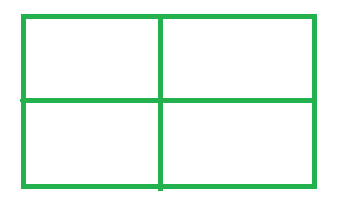
Next, we will shade the number of boxes equivalent to the numerator of the fraction, which in our case is 3. We will have:
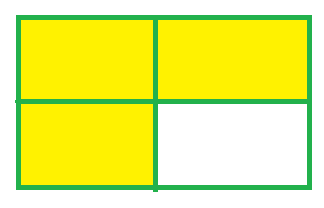
The shaded part thus represents our fraction $\frac{3}{4}$.
Multiplication of fractions can also be represented in a similar manner. Let us understand it through an example.
Suppose we want to evaluate $\frac{2}{3}\times \frac{4}{5}$ with the help of pictorial representation. The following steps will be followed for this purpose.
Step 1 – We first make a rectangle which we shall use as a whole number. Let the rectangle be represented in the below manner.
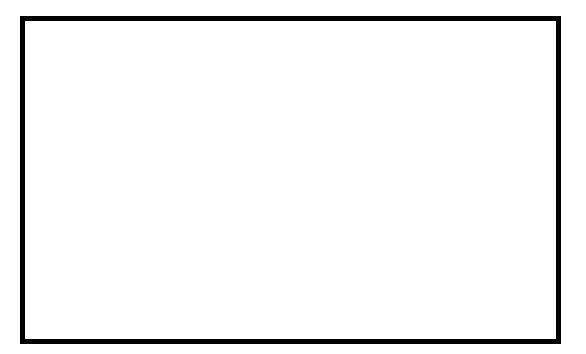
Step 2 – To mark $\frac{4}{5}$ we first divide the rectangle into 5 equal horizontal parts. We will now have:
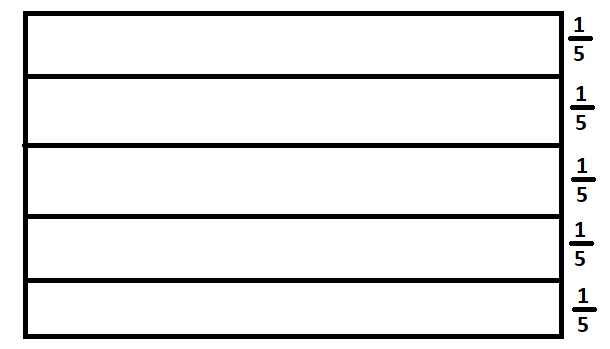
We can see that each horizontal part is now one of the five parts which can also be written as $\frac{1}{5}$.
Step 3 – Next, we shade four of these 5 parts as we have a numerator as 4 in our fraction. We will get:
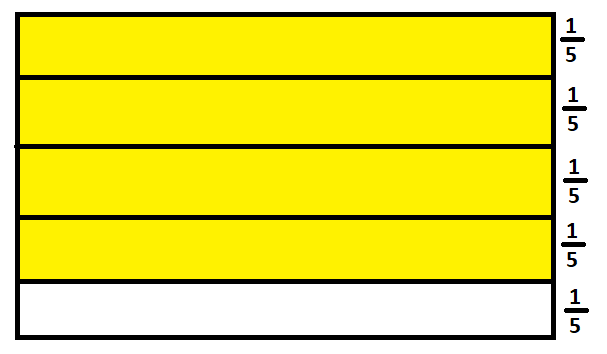
So, we have now plotted our first fraction. Next, we will plot our second fraction in the same rectangle to obtain our result for the multiplication of the two fractions.
Step 4 – To mark $\frac{2}{3}$, we divide the same rectangle into 3 equal parts, but this time it will be a vertical division. We will get,
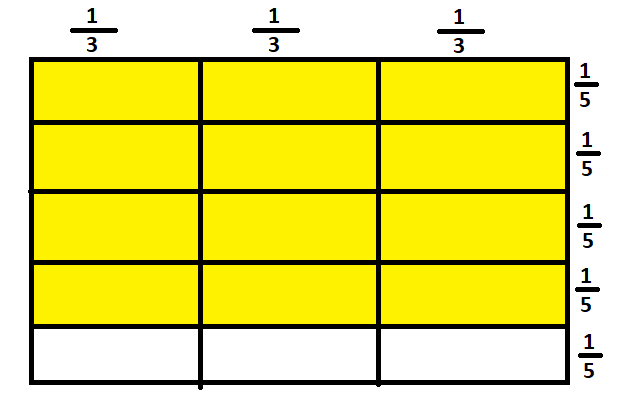
We can see that every vertical part represents one out of the total three parts when divided vertically which can also be written as $\frac{1}{3}$.
Step 5 – Now we shade 2 out the three vertical parts, we will get:
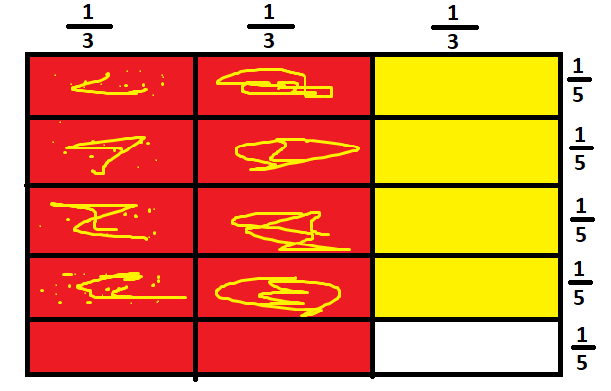
Now, identify the part that has been shaded twice. We can see that the parts that have been shaded twice have both colours while the parts that have been shaded once have one colour only.
Count the number of parts that have been shaded twice. We get 8 parts out of a total of 15 parts. Therefore, we can say that
$\frac{2}{3}\times \frac{4}{5}=\frac{8}{15}$
Let us check the same using our formula for the multiplication of two fractions. We know that:
Product of fractions = $\frac{Product\,of\,the\,Numerators}{Product\,of\,the\,denominators}$
Therefore,
$\frac{2}{3}\times \frac{4}{5}=\frac{2\times4}{3\times5}=\frac{8}{15}$
Hence, we can see that we have correctly represented the above multiplication in pictorial form.
Solved Examples
Multiply
- $\frac{2}{9}$ by $\frac{4}{5}$
- 4 x $\frac{1}{4}$
- $\frac{13}{33}$ x 22
Solution
1. We have to multiply $\frac{2}{9}$ by $\frac{4}{5}$
To multiply two fractions we have the formula:
Product of fractions = $\frac{Product\,of\,the\,Numerators}{Product\,of\,the\,denominators}$
Therefore,
$\frac{2}{9}\times \frac{4}{5}=\frac{2\times4}{9\times5}=\frac{8}{45}$
Hence, $\frac{2}{9}\times \frac{4}{5}=\frac{8}{45}$
2. We have to multiply 4 by $\frac{1}{4}$
We can see that one of the numbers is a whole number while the other is a fraction. We know that the multiplication of a whole number by a fraction is given by:
Fraction x Whole Number = $\frac{Numerator\,of\,the\,Fraction\,\times \,Whole\,Number}{Denominator\,of\,the\,Fraction}$
Therefore,
$4\times \frac{1}{4}=\frac{4\times1}{4}=1$
Hence, $4\times \frac{1}{4}=1$
3. We have to multiply $\frac{13}{33}$ by 22
We can see that one of the numbers is a whole number while the other is a fraction. We know that the multiplication of a whole number by a fraction is given by:
Fraction x Whole Number = $\frac{Numerator\,of\,the\,Fraction\,\times \,Whole\,Number}{Denominator\,of\,the\,Fraction}$
Therefore,
$\frac{13}{33}\times 22=\frac{13\times22}{33}$

=$\frac{13\times2}{3}=1\frac{26}{3}$
Hence, $\frac{13}{33}\times 22=\frac{26}{3}$
Ronald wants to use $\frac{1}{2}$ of a page for writing his story. He uses $\frac{1}{3}$ of this $\frac{1}{2}$ page to make pictures. How much of the whole page has been used for the pictures?
Solution: We have been given that:
Ronald wants to use $\frac{1}{2}$ of a page for writing his story
The portion of the page used for making pictures $\frac{1}{3}$ of this $\frac{1}{2}=\frac{1}{3}$ of this $\frac{1}{2}$
In order to find out how much of the whole page has been used for the pictures, we need to multiply $\frac{1}{3}$ by $\frac{1}{2}$.
We know that
Product of fractions = $\frac{Product\,of\,the\,Numerators}{Product\,of\,the\,denominators}$
$\frac{1}{3}\times \frac{1}{2}=\frac{1\times1}{3\times2}=\frac{1}{6}$
Hence, $\frac{1}{6}$ of the whole page has been used for the pictures by Ronald.
Peter reads a book in $1\frac{3}{4}$ an hour every day. He reads the entire book in 6 days. How many hours in all were required by Peter to read the book?
Solution: We have been given that:
Number of hours spent by Peter on reading a book every day = $1\frac{3}{4}$
Number of days taken by Peter to read the complete book = 6
We need to find out how many hours in all were required by Peter to read the complete book. To find this out we will have to multiply = $1\frac{3}{4}$ by 6
But we can see that one of the fractions is a mixed number. Therefore, we will first have to convert it into an improper fraction.
Therefore,
$1\frac{3}{4}=\frac{4\times1+3}{4}=\frac{7}{4}$
Now we can multiply the two fractions.
We know that
Fraction x Whole Number = $\frac{Numerator\,of\,the\,Fraction\,\times \,Whole\,Number}{Denominator\,of\,the\,Fraction}$
Therefore,
$\frac{7}{4}\times6=\frac{7\times6}{4}=\frac{21}{2}=10\frac{1}{2}$
Hence, the number of hours required by Peter to read the complete book = $ 10\frac{1}{2}$ hours.
Find the area of a rectangular park which is $41\frac{2}{3}$ m long and $18\frac{3}{5}$ m broad.
Solution: We have been given that:
Length of the rectangle = $ 41\frac{2}{3} $ m
The breadth of the rectangle = $18\frac{3}{5}$ m
We need to find the area of this rectangle.
We know that the area of a rectangle with a given length and breadth is equal to the product of its length and breadth. Hence
Area of a rectangle = Length x Breadth
Therefore, in order to find out the area of the rectangle we need to multiply the two fractional values give to us in the question.
Now, we also know that,
Product of fractions = $\frac{Product\,of\,the\,Numerators}{Product\,of\,the\,denominators}$
But, before proceeding ahead with the multiplication, we should first check our fractional values. We can see that both the values are in mixed fractions. Therefore, we will first need to convert these values into improper fractions.
Therefore, we have
$41\frac{2}{3}=\frac{41\times3+2}{3}=\frac{125}{3}$
Also,
$18\frac{3}{5}\frac{18\times5+3}{5}=\frac{93}{5}$
Now that we have both the fractional values as improper values we can go ahead with our multiplication.
Therefore,
$\frac{125}{3}\times \frac{93}{5}=775$ m2
Hence, the area of the rectangular park with the dimensions, $41\frac{2}{3}$ m and $18\frac{3}{5}$ m is 775 m2.
A carton contains 40 boxes of nails and each box weighs $3\frac{3}{4}$ kg. What would be the weight of a carton of nails?
Solution: We have been given that
A carton contains 40 boxes of nails.
Also, the weight of the box of nails = $3\frac{3}{4}$ kg
Now, we need to find out the total weight of a carton that has 40 boxes of nails.
In order to find this out, we will need to multiply the weight of one box of nails by the total number of boxes. But before that, we can see that the fractional value of the weight of one box is in a mixed fraction. Therefore, we will first convert it into an improper fraction. Therefore, we have:
$3\frac{3}{4}=\frac{15}{4}$
Now, we know that
Fraction x Whole Number = $\frac{Numerator\,of\,the\,Fraction\,\times \,Whole\,Number}{Denominator\,of\,the\,Fraction}$
Therefore,
$\frac{15}{4}\times 40=\frac{15\times 40}{4}=150$ kg
Hence, the total weight of 40 boxes of nails = 150 kg.
Multiplying Fractions Visually
The three examples below illustrate the multiplication of fractions.
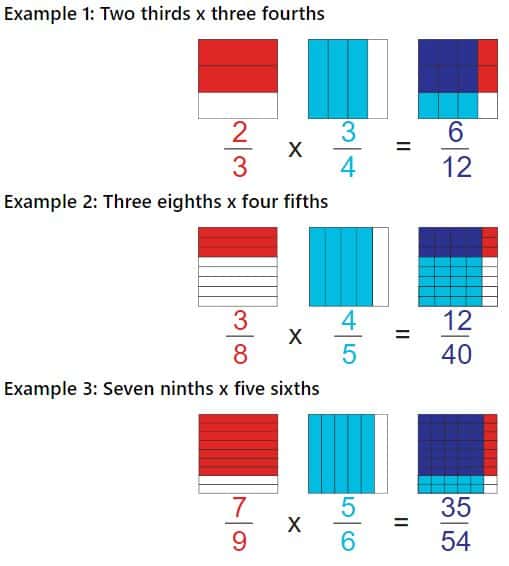
Common error when multiplying fractions by a whole number
The example below shows an error that is made by students when the multiplication involves a whole number.

Multiplying the numerator and denominator by the same number is the same as multiplying the fraction by 1.
Multiplying Fractions Worksheet Generators
- Multiplying Fractions e.g. 4/7 x 3/4
- Multiplying Fractions and Numbers e.g. 4 x 6/7
- Multiplying Fractions and Mixed Numbers e.g. 4 x 3 6/7
- Multiplying Mixed Numbers e.g. 4 2/3 x 5 3/4
Use the worksheets above to practice multiplying with fractions.
Recommended Worksheets
Subtraction of Proper Fractions (Olympic Games Themed) Worksheets
Simplifying Fractions (Living Things Themed) Worksheets
Ordering Fractions (Birthday Themed) Worksheets









